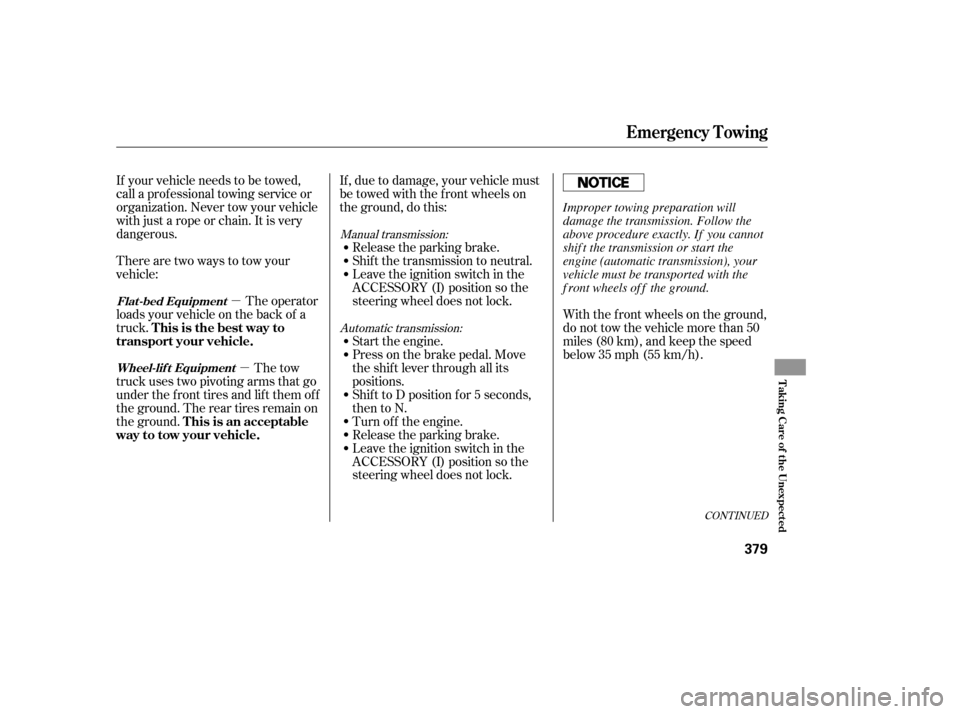Page 399 of 436

�µ �µ
�µ �µ �µ�µ�µ�µ
�µ�µ�µ�µ�µ�µ
�Î�Î
�Î�Î
�µ�µ
�µ�µ�Î�Î
�Î�Î�µ�µ
�µ �µ �µ �µ�µ �µ �µ �µ
�Î �Î
Circuits Protected No. Circuits Protected
No.
Circuits Protected Amps.
No. Amps. Amps.
Not Used
Not Used
Sub Fan Motor
Wiper Motor
Main Fan Motor
Driver’s Side Light Main
Driver’s Side Fuse Box
Passenger’s Side Light Main4556789
10111213141516171819192021 Driver’s Side Fuse Box
IG Main
Rear Defroster
Sub Fan Motor
Not Used
Not Used
Not Used
Heater Motor
Hazard
Horn, Stop
Not Used
Not Used
IG Coil
FI Sub
Back Up
Interior Lights
FI Main
DBW
Not Used
Back Up, FI ECU
MG Clutch
Fan Relay
Battery
Battery
Passenger’s Side Fuse Box
Not Used
ABS/VSA
ABS/VSA Motor
Passenger’s Side Fuse Box
Not Used
30 A
30 A
30 A
30 A
(60 A) 30 A
100 A
120 A
40 A
40 A
30 A
(40 A) (40 A)
50 A
40 A
20 A
40 A
15 A
20 A
15 A
15 A
10 A
7.5 A
15 A
15 A
7.5 A
7.5 A
7.5 A
2.4
engine models
V6 models
1: 2:
3738
26 32 33343536
122122232425
12
12
3131
111112
12
Fuse Locations
376
UNDER-HOOD FUSE BOX
�����—�����—�����y�
���������
���y���
�)�������
���y�������
�y
Page 402 of 436

�µ�µ
If your vehicle needs to be towed,
call a prof essional towing service or
organization. Never tow your vehicle
with just a rope or chain. It is very
dangerous.
The operator
loads your vehicle on the back of a
truck.
Therearetwowaystotowyour
vehicle: If , due to damage, your vehicle must
be towed with the f ront wheels on
the ground, do this:
Release the parking brake.
Shif t the transmission to neutral.
Leave the ignition switch in the
ACCESSORY (I) position so the
steering wheel does not lock. With the f ront wheels on the ground,
do not tow the vehicle more than 50
miles (80 km), and keep the speed
below35mph(55km/h).
The tow
truck uses two pivoting arms that go
under the f ront tires and lif t them of f
the ground. The rear tires remain on
the ground.
Leave the ignition switch in the
ACCESSORY (I) position so the
steering wheel does not lock.
Turn of f the engine.
Release the parking brake.
Shif t to D position f or 5 seconds,
then to N.
Start the engine.
Press on the brake pedal. Move
the shif t lever through all its
positions.
Manual transmission:
Automatic transmission:
CONT INUED
Flat -bed EquipmentWheel-lif t Equipment
T his is the best way to
transport your vehicle.
This is an acceptable
way to tow your vehicle.
Emergency T owing
T aking Care of t he Unexpect ed
379
Improper towing preparation will
damage the transmission. Follow the
above procedure exactly. If you cannot
shif t the transmission or start the
engine (automatic transmission), your
vehicle must be transported with the
f ront wheels of f the ground.
�����—�����—�����y�
�������������y���
�)�������
���y���������y
Page 404 of 436
Your vehicle has several identif ying
numbers in various places.
The vehicle identif ication number
(VIN) is the 17-digit number your
dealer uses to register your vehicle
f or warranty purposes. It is also
necessary f or licensing and insuring
your vehicle. The easiest place to
find the VIN is on a plate fastened to
the top of the dashboard. You can
seeitbylookingthroughthe
windshield on the driver’s side. It is
also on the certification label
attached to the driver’s doorjamb,
and is stamped on the engine
compartment bulkhead. The VIN is
also provided in bar code on the
certif ication label.
Identif ication Numbers
382
CERTIFICATION LABEL
VEHICLE IDENTIFICATION NUMBER (VIN)
�����—�����—�����y�
�������������y���
�)�������
���y���������y
Page 405 of 436
The transmission number is on a
label on top of the transmission.
The engine number is stamped on
the f ront of the engine block.
Identif ication Numbers
T echnical Inf ormation
383
ENGINE NUMBER
2.4
engine models
V6 models AUTOMATIC TRANSMISSION NUMBER
ENGINE NUMBER
AUTOMATIC
TRANSMISSION
NUMBER
MANUAL TRANSMISSION NUMBER
�����—�����—�����y�
������
������y���
�)�������
���y���������y
Page 406 of 436

�µ�µ�Î �Î
�Î�Î
�Î �Î
�Î �Î
Specif icat ions (2.4engine models)
384
Dimensions
Seating Capacities
Capacities
Weights
Air Conditioning
Engine 110.2 in (2,800 mm)
62.6 in (1,590 mm)
Length
Width
Height
Wheelbase
Track
194.1 in (4,930 mm)
72.7 in (1,847 mm)
58.1 in (1,475 mm)
4.8 US qt (4.5
)
2.6 US qt (2.5)
6.9 US qt (6.5
)
2.6 US qt (2.5)
2.1 US qt (2.0)
2.0 US qt (1.9)
5.6 US qt (5.3)
4.2 US qt (4.0)
4.4 US qt (4.2)
2.11 US gal (8.0
)
2.14 US gal (8.1)
1.56 US gal (5.9
)
1.59 US gal (6.0)
5 23
62.2 in (1,580 mm) Total
FrontRear
Fuel tank
Engine
coolant
Engine oil
Manual trans-
mission fluidAutomatic
transmission
fluid
Windshield
washer
reservoir
Including the coolant in the reserve tank and that remaining in the
engine
Reserve tank capacity: 0.180 US gal (0.68
)
Excluding the oil remaining in the engine
Gross vehicle weight rating See the certification label attached
to the driver’s doorjamb.
Refrigerant type
Charge quantity
Lubricant type HFC-134a (R-134a)
14.1 15.9 oz (400 450 g)
ND-OIL8
Water cooled 4-stroke
DOHC i-VTEC 4-cylinder gasoline engine
3.43 x 3.9 in (87.0 x 99.0 mm) 144 cu-in (2,354 cm
)
10.5 : 1
ILZKR7B11S SXU22HCR11S
Type
BorexStroke
Displacement
Compression ratio
Spark plugs (U.S.)
Spark plugs (Canada)
SXU22HCR11S
ILZKR7B11S
DILZKR7A11GS 18.5 US gal (70.0
)
Approx.
Change Manual Automatic
Total ManualAutomatic
1: 2:
NGK:
DENSO: Change
Including filter
Without filter
Total
ChangeTotal
ChangeTotal U.S.
Canada
Front/Rear
ULEV PZEV
1: 2: EX,EX-L
NGK:NGK:
DENSO:
LX, LX-P1 2
1 2
�����—�����—�����y�
������
������y���
�)�������
���y���������y
Page 407 of 436

�µ
�µ �µ�µ�µ�µ�µ�µ�µ�µ�µ�µ�µ�µ�µ �µ �µ�µ�µ�µ�µ
�Î �Î�Î
�Î
�Î �Î
�Î
�Î
�Î
Specif icat ions (2.4engine models)
T echnical Inf ormation
385
Lights Battery Fuses
Tires
Alignment
12 V 60 W (HB3)
12 V 51 W (HB4)
12 V 21/5 W
21 W
12 V 21 W
Headlights
Front turn signal/parking lights
Front side marker lights
Rear turn signal lights
Back-up lights
Stop/taillights
License plate lights
High-mount brake light
Ceiling light
Spotlights
Trunk light
Front door courtesy lights
Vanity mirror lights 12 V 2 W
12 V 2 CP
12 V 5 W
12 V 8 W
12 V 8 W
12 V 21 W
12 V 5 W
12 V 21/5 W
12 V 3 CP
12 V
Capacity 12 V 12 V
12 V
12 V
12 V
12 V36 AH/5 HR
38 AH/5 HR
45 AH/20 HR
47 AH/20 HR
52 AH/5 HR
65 AH/20 HR Interior
Under-hood Size
Pressure
P215/60R16 94H
P225/50R17 93V
T135/80D16 101M
32 psi (220 kPa , 2.2 kgf/cm
)
30 psi (210 kPa , 2.1 kgf/cm)
60 psi (420 kPa , 4.2 kgf/cm
)
Toe-in
CamberCaster 0.00 in (0.0 mm)
0.08 in (2.0 mm)
0°
1°
3°48’
See page 377 or the fuse label
attached on the side panel.
See page 378 or the fuse label
attached to the inside of the fuse
box door.
See page 376 or the fuse box
cover.
HighLow
: Passenger’s side
Driver’s side
Front/Rear
Spare
Front/Rear
Spare
1: 2:
FrontRear
FrontRear
Front
(Amber)
LX, LX-P
EX, EX-L
PZEV engine model, and Canadian models
2
1
2
1
�����—�����—�����y�
������
������y���
�)�������
���y���������y
Page 408 of 436

�µ�µ�Î �Î
�Î
�Î
Specif ications (V6 models)
386
Dimensions
Seating Capacities
Capacities
Weights
Air Conditioning
Engine 110.2 in (2,800 mm)
Length
Width
Height
Wheelbase
Track 194.3 in (4,936 mm)
72.7 in (1,847 mm)
58.1 in (1,475 mm)
62.2 in (1,580 mm)Total
FrontRear
523
Fuel tank
Engine
coolant
Engine oil Automatic
transmission
fluid
Windshield
washer
reservoir 1.74 US gal (6.6
)
2.27 US gal (8.6)
4.2 US qt (4.0
)
4.5 US qt (4.3)
5.3 US qt (5.0
)
3.5 US qt (3.3)
7.9 US qt (7.5)
2.6 US qt (2.5
)
4.8 US qt (4.5)
Including the coolant in the reserve tank and that remaining in the
engine
Reserve tank capacity:
Excluding the oil remaining in the engine 0.180 US gal (0.68
)
Gross vehicle weight rating See the certification label attached
to the driver’s doorjamb.
Refrigerant type
Charge quantity
Lubricant type HFC-134a (R-134a)
14.1 15.9 oz (400 450 g)
ND-OIL8
3.50 x 3.66 in (89.0 x 93.0 mm) 212 cu-in (3,471 cm
)
10.5 : 1
ILZKR7B11 SXU22HCR11DILZKR7A11G
Type
BorexStroke
Displacement
Compression ratio
Spark plugs (U.S.)
Spark plugs (Canada) ILZKR7B11
SXU22HCR11 18.5 US gal (70.0
)
Water cooled 4-stroke
SOHC i-VTEC 6-cylinder (V6)
gasoline engine Approx.
1: 2: Change
Including filter
Without filter
Total
ChangeTotal U.S.
Canada
ChangeTotal
ULEVPZEV
Front/Rear
NGK:
DENSO:NGK:NGK:
DENSO:
2
1
�����—�����—�����y�
���������
���y���
�)�������
���y�������
�y
Page 416 of 436

�Î
�ÎThe burning of gasoline in your
vehicle’s engine produces several by-
products. Some of these are carbon
monoxide (CO), oxides of nitrogen
(NOx), and hydrocarbons (HC).
Gasoline evaporating f rom the tank
also produces hydrocarbons. Con-
trolling the production of NOx, CO,
and HC is important to the environ-
ment. Under certain conditions of
sunlight and climate, NOx and HC
react to f orm photochemical ‘‘smog.’’
Carbon monoxide does not contri-
bute to smog creation, but it is a
poisonous gas. The United States Clean Air Act
sets standards f or automobile
emissions. It also requires that
automobile manufacturers explain to
owners how their emissions controls
workandwhattodotomaintain
them. This section summarizes how
the emissions controls work.
In Canada, Honda vehicles comply
with the Canadian emission
requirements, as specif ied in an
agreement with Environment
Canada, at the time they are
manuf actured.
Your vehicle has a positive
crankcase ventilation system. This
keeps gasses that build up in the
engine’s crankcase f rom going into
the atmosphere. The positive
crankcase ventilation valve routes
them from the crankcase back to the intake manif old. They are then
drawn into the engine and burned.
As gasoline evaporates in the f uel
tank, an evaporative emissions
control canister f illed with charcoal
adsorbs the vapor. It is stored in this
canister while the engine is of f . Af ter
the engine is started and warmed up,
the vapor is drawn into the engine
and burned during driving.
The onboard ref ueling vapor
recovery (ORVR) system captures
the f uel vapors during ref ueling. The
vapors are adsorbed in a canister
f illed with activated carbon. While
driving, the f uel vapors are drawn
into the engine and burned of f .
The Clean Air Act
Crankcase Emissions Control
System
Evaporative Emissions Control
System
Onboard Ref ueling Vapor
Recovery
Emissions Cont rols
394
�����—�����—�����y�
�������������y���
�)�������
���y���������y